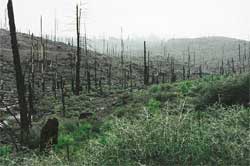Troubled history
Troubled history

Federal ownership and management of forests began with the Forest Reserve Act of 1891 (also known as the Creative Act) that created forest reserves to protect against excessive logging. In 1905, Congress established the fs under the department of agriculture. It was given the task of managing the national forests system. Public forests comprise about 91.125 million ha of land, of which 75.735 million ha (83 per cent) is part of the national forests system.
Till World War II, there was hardly any commercial logging in national forests. During this period, the forest products industry often opposed federal timber sales. Starting at least as early as the 1960s, the practice of clearfelling met with a lot of opposition from environmentalists, who argued that it was destroying wildlife habitat, reducing diversity of flora and fauna, and causing soil erosion.The fs responded by claiming that clearfelling was an economically efficient means of regenerating tree species, saying that technical decisions surrounding forest management practices should be left to the professionals, a view endorsed by the forest products industry and Congress. By placing the fs under the department of agriculture, Congress had sent out a clear message that trees were to be treated as any other agricultural crop, with repeated cycles of harvesting following planting.
For members of Congress, high timber harvests meant jobs in their constituencies and large campaign contributions from a grateful timber industry. For the fs , higher timber sales meant larger appropriations from Congress as its budget allocations are tied to timber sales. Environmentalists failed to break this greedy alliance.
Although the National Forest Management Act of 1976 (nfma) did not put an end to clearfelling, this act, along with the National Environmental Policy Act of 1969 (nepa), opened a new avenue of attack for environmentalists. Under the nepa , the fs was required to publish a detailed environmental impact statement for any project it was planning to undertake in the near future, while under the nfma , the fs had to involve the public in the planning process and allow them to scrutinise the projects. Taking advantage of these provisions, environmentalists managed to bring stay orders against a number of projects that were suspected to be detrimental to the environment. They were able to curb the felling of trees.
One of the most famous of these law suits was regarding the Northern Spotted Owl. As a result of protests by environmentalists in May 1991, us district court judge William Dwyer issued an injunction against the fs on grounds that the current forest management practices were threatening the habitat of the Northern Spotted Owl, and were violating the Endangered Species Act. The owl primarily inhabits mature and old growth forests in the Pacific Northwest, and these forests were being rapidly logged. The injunction prevented timber sales from public lands throughout the Northwest, with timber sales falling by 80 per cent in 1994. From the 1980s to 1994, timber production from the Plumas national forest dropped by 75 per cent.
This decline was adversely affecting communities that were highly dependent on timber, especially in places such as Susanville, Chester, Quincy, Loyalton, Bieber and Greenville (all falling in Lassen, Plumas and Sierra counties in California). Employment of several people living in these areas was already under threat from structural changes in the timber industry and reduction in the fs work force.
Some of the loggers even resorted to violence. Michael Jackson, an environmental activist and a public interest lawyer, has a bullet hole in his office window that reminds him of the antagonism that once existed. The gridlock over timber supply led to a lot of tension in the community of Quincy. It was clear that the issue was complicated and any lasting solution required to be acceptable to the various parties.







